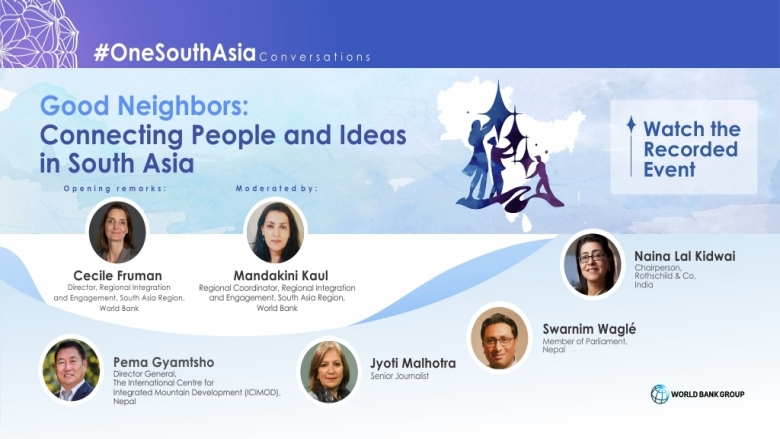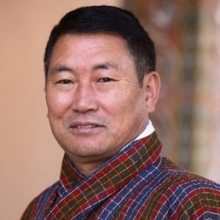- OVERVIEW
- SPEAKERS
- ABOUT #OSA SERIES
- RELATED
This is a recorded event.
Also, watch here the Fire Side Chat with Ambassador Shyam Saran, Chairperson, India International Centre and Cecile Fruman, Director, Regional Integration, World Bank.
About the Event: Our 18th #OneSouthAsia Conversation was held in partnership with the India International Center, New Delhi, where we brought together prominent South Asian voices to discuss ways to strengthen people-to-people connectivity and ideas across borders. This Conversation builds on our report, Good Neighbours: Advancing Regional Integration, Cooperation and Engagement in South Asia, which showcases successful cross-border stories that promote understanding, trust, and people-to-people contacts. This is the recorded version of the panel discussion.

Background: South Asia is one of the least integrated regions globally in terms of trade and connectivity. The intraregional trade is barely 5% of the region’s total trade. In comparison, intraregional trade share is about 60% of the total trade in Europe, 50%in East Asia and Pacific, 22 % in Sub-Saharan Africa, 25% in the Association of Southeast Asian Nations (ASEAN). The average costs of trade within South Asia are 20 % higher relative to country pairs in the ASEAN. Given the high connectivity and trade costs, for an Indian company, it is 15-20 % less expensive to trade with Brazil or Germany than with Bangladesh.
As we analyse the low levels of intra-regional cooperation in South Asia and highlight how trade, connectivity, and infrastructure linkages are amongst the lowest in the world, we often overlook the small but significant ways in which people of the region come together, with a great deal of innovation and fortitude and mostly in the face of significant barriers. For example, since the last 20 years, hundreds of undergraduate students have convened annually at the South Asia Economics’ Student Meet to exchange academic research, and to build lasting bonds and friendships, or a South Asian symphony orchestra, or cooperation amongst scientists to address the effects of climate change. These are all small but effective examples of cooperation.
This discussion builds on such examples and explore future pathways of people-to-people connectivity, and what will it take to connect people across borders.
Panelists
More about #OneSouthAsia Conversation:
Our #OneSouthAsia conversation is a part of an ongoing bi-monthly series that explores ideas for regional cooperation in economic connectivity, climate change, and human development in South Asia. The online conversation will broadcast on the World Bank Group channels, and is a public event, which does not require pre-registration. The event is targeted toward a mixed audience including policy makers, regional influencers and stakeholders, academic institutes, civil society organizations, private sector, and the general population in South Asia.
Examples of Previous #OneSouthAsia Conversations:
VISIT THE ONESOUTHASIA CONVERSATIONS SERIES PAGE
Flowing Waters: Harnessing Transboundary Rivers in South Asia (November, 2024)
Leveling Up:Advancing Higher Education Cooperation in South Asia (July, 2024)
Equalizing Opportunities: Women in Regional Trade in South Asia (April, 2024)
Striving for Clean Air in South Asia: Effective Regional Responses l JAN 19, 2023
Resilient Together: Managing Disasters and Climate Risks in South Asia | OCTOBER 31, 2022
Deepening Economic Linkages between South Asia and Southeast Asia | JULY 28, 2022
Innovate and Mitigate: Emerging Solutions for Climate Resilience in South Asia | MAY 23, 2022
Connecting across Borders: South Asia's Digital Opportunity l MARCH 31, 2022
Toward a Green, Clean and Energy-Secure South Asia l JANUARY 31, 2022
Path to Recovery: Embracing Intraregional Investments In South Asia l NOVEMBER 22, 2021
Harnessing Technology to Build Human Capital in South Asia l SEPTEMBER 16, 2021
Breathing Uneasy: Regional Response to Air Pollution in South Asia l JULY 27, 2021
Turning the Tide on Marine Plastics in South Asia l MAY 5, 2021
Pivoting in a Pandemic: Women Entrepreneurs Tap Regional Opportunities l Jan, 29, 2021
Feeding South Asia in Times of Crisis: Building Resilient Agriculture Supply Chains l NOVEMBER 23, 2020
How Can Regional Cooperation Support South Asia’s COVID-19 Recovery? l SEPTEMBER 2, 2020
Watch Fire Side Chat with Ambassador Shyam Saran
Read 10 case studies of Good Neighbors
Visit our OneSouthAsia Website
Email us at OneSouthAsia@worldbank.org
Tag us #OneSouthAsia
Date: February 29, 2024
Time: 08:00 AM - 09:15 AM ET
Location: Online






